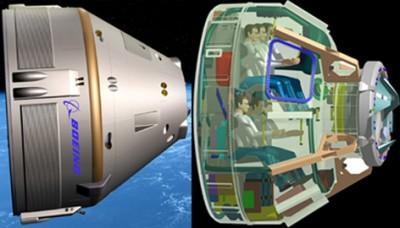Thu, Jun 28, 2012
CST-100 Attitude Control System Will Be Comprised Of Twenty-Four Of The Thrusters
A series of tests on a thruster destined for Boeing's Commercial Space Transportation spacecraft, designated CST-100, was completed recently by Pratt & Whitney Rocketdyne. Boeing is one of several companies working to develop crew transportation capabilities under the Commercial Crew Development Round 2 agreement with NASA's Commercial Crew Program.

Twenty-four thrusters will be part of the spacecraft's orbital maneuvering and attitude control system (OMAC), giving the CST-100 the ability to maneuver in space and during re-entry. The thrusters also will allow the spacecraft to separate from its launch vehicle if an abort becomes necessary during launch or ascent.
"Boeing and Pratt and Whitney Rocketdyne know what it takes to develop safe systems and subsystems," said NASA Commercial Crew Program Manager Ed Mango. "They're building on the successes of their past, while pushing the envelope with next-generation ideas to create a spacecraft for low Earth orbit transportation."
During tests conducted at the White Sands Space Harbor in Las Cruces, NM, an OMAC thruster was fired in a vacuum chamber that simulated a space-like environment of 100,000 feet. The tests verified the durability of the thrusters in extreme heat, evaluated the opening and closing of its valves and confirmed continuous combustion and performance. "We're excited about the performance of the engine during the testing and confident the OMAC thrusters will affordably meet operational needs for safe, reliable human spaceflight," said Terry Lorier, Pratt and Whitney Rocketdyne's Commercial Crew Development program manager.
All of NASA's industry partners, including Boeing, continue to meet their established milestones in developing commercial crew transportation capabilities.
NASA also is developing the Orion spacecraft and Space Launch System (SLS), a crew capsule and heavy-lift rocket that will provide an entirely new capability for human exploration beyond low Earth orbit. Designed to be flexible for launching spacecraft for crew and cargo missions, SLS and Orion will expand human presence beyond low Earth orbit and enable new missions of exploration across the solar system. (Image provided by Boeing)
More News
Aviation Governance Secured...At Least For a While The National Business Aviation Association similarly applauded the passage of the FAA's recent reauthorization, contentedly recou>[...]
Emphasis On Growing The Future of Aviation Through Concentration on 'AFFORDABLE FLYERS' It's been a number of years since the Latest Edition of Jim Campbell's HUGE SportPlane Resou>[...]
Amazilia Aerospace GmbH, Develops Digital Flight Control, Flight Guidance And Vehicle Management Systems Textron eAviation has acquired substantially all the assets of Amazilia Aer>[...]
Honeywell's Primus Brings New Tools and Niceties for Hawker Operators Hawker 4000 business jet operators have a new installation on the table, now that the FAA has granted an STC f>[...]
Company Celebrates Niche-but-Important Advancement in Industry Standards Echodyne has announced full integration of its proprietary 'EchoFlight' radar into the e American Aerospace>[...]
 Bolen Gives Congress a Rare Thumbs-Up
Bolen Gives Congress a Rare Thumbs-Up The SportPlane Resource Guide RETURNS!!!!
The SportPlane Resource Guide RETURNS!!!! Buying Sprees Continue: Textron eAviation Takes On Amazilia Aerospace
Buying Sprees Continue: Textron eAviation Takes On Amazilia Aerospace Hawker 4000 Bizjets Gain Nav System, Data Link STC
Hawker 4000 Bizjets Gain Nav System, Data Link STC Echodyne Gets BVLOS Waiver for AiRanger Aircraft
Echodyne Gets BVLOS Waiver for AiRanger Aircraft



